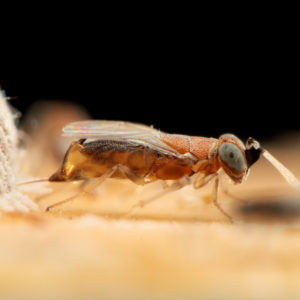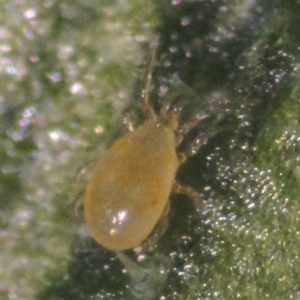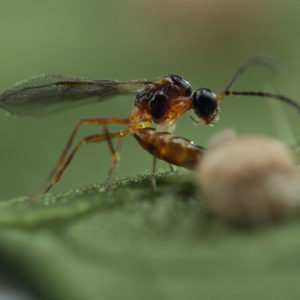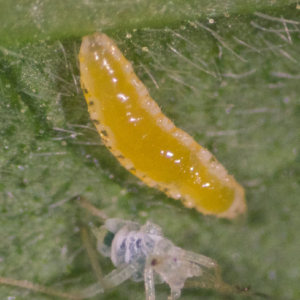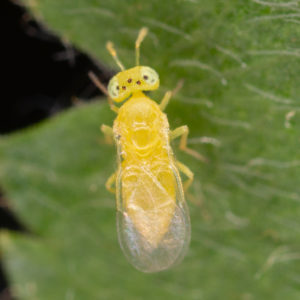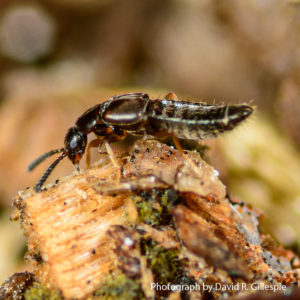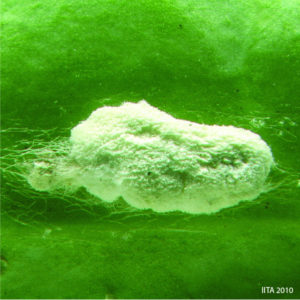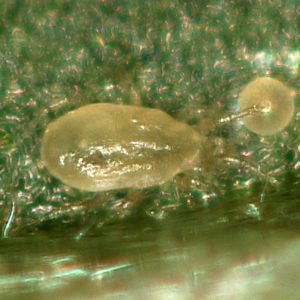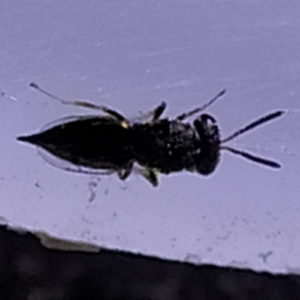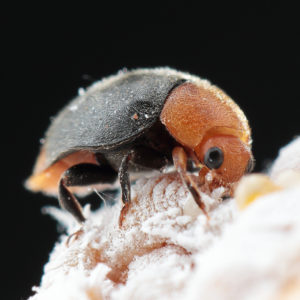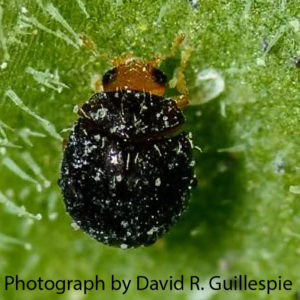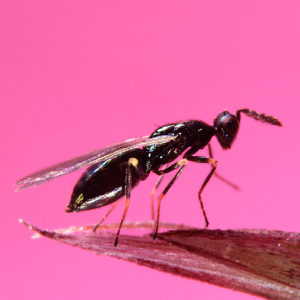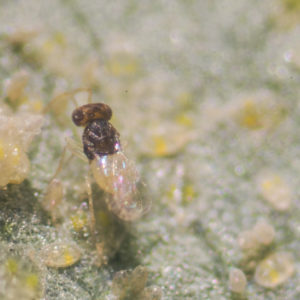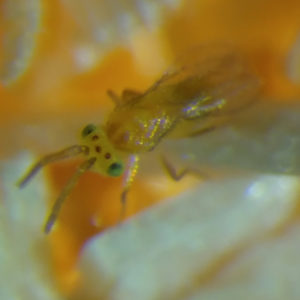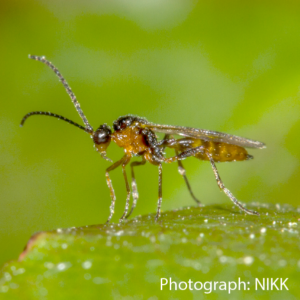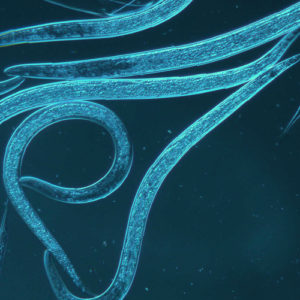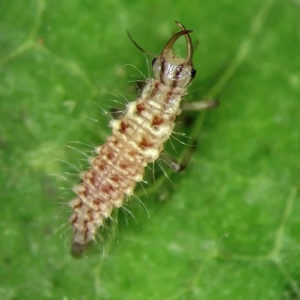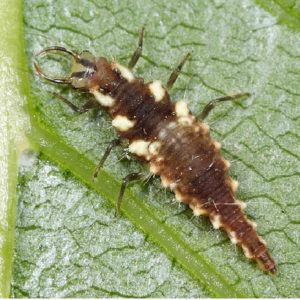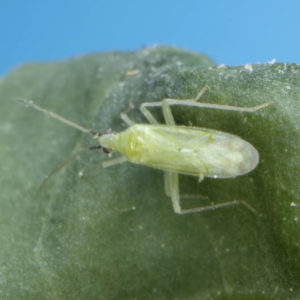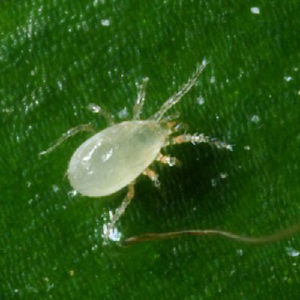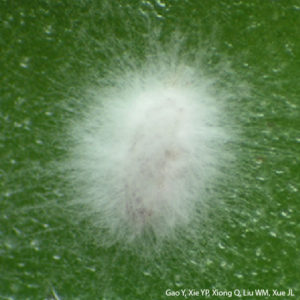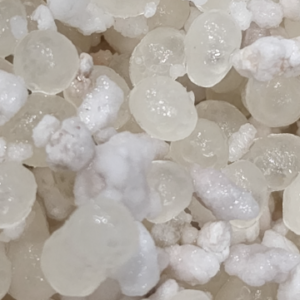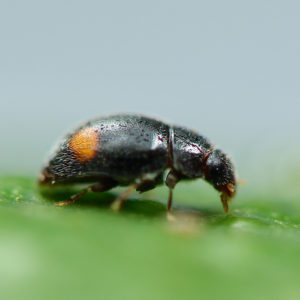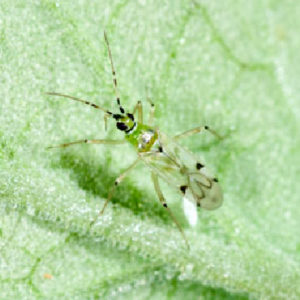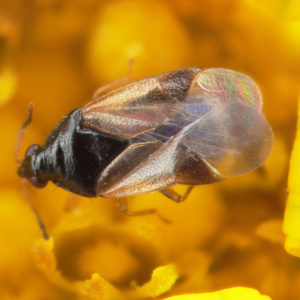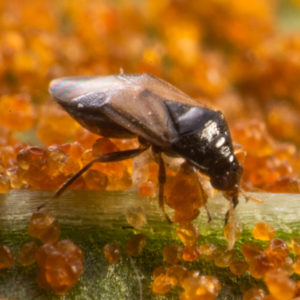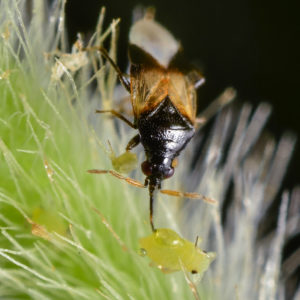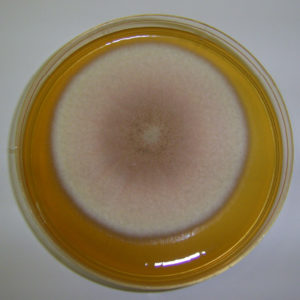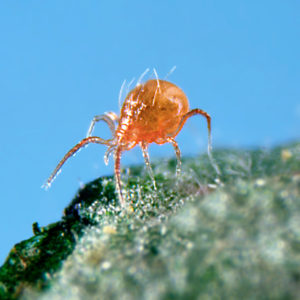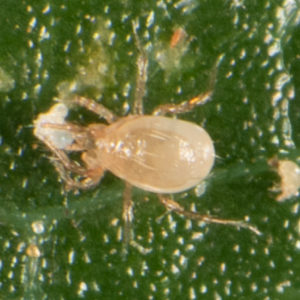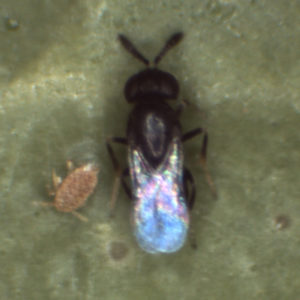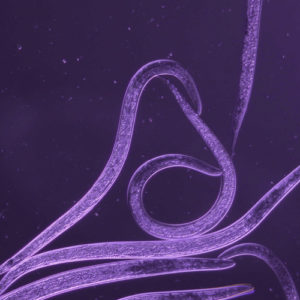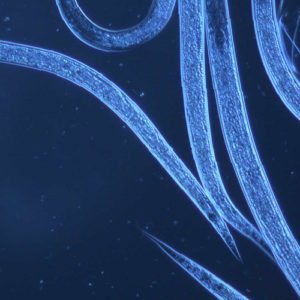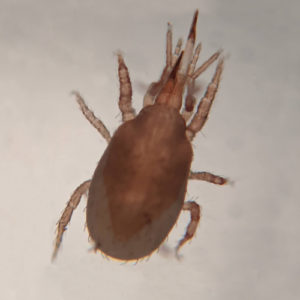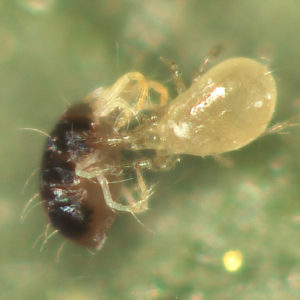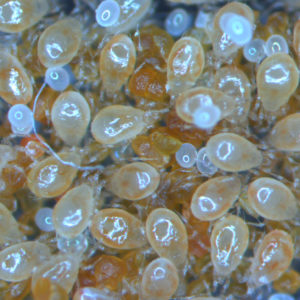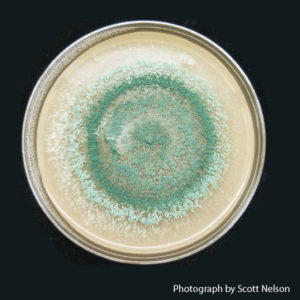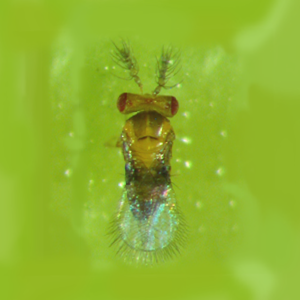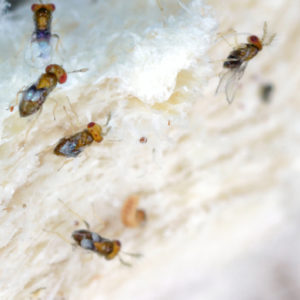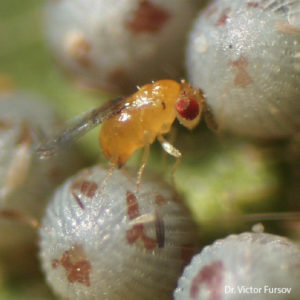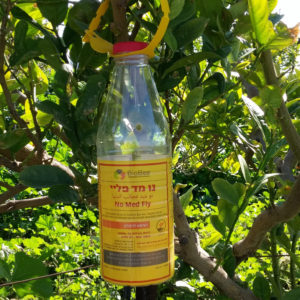The female wasp prefers to lay its eggs singly, inside the third instar larvae and young adult female mealybugs. When the parasitoid larva hatches, it feeds on the internal organs of its host and develops within it. The pupal stage appears within a “mummy” (which is the hardened skin of the dead mealybug), when the adult emerges it gnaws an irregular exit hole at the posterior end of the “mummy”.
BioAndersoni
BioAndersoni is a predatory mite that feeds on small arthropod prey and pollen. Less than 1mm in length, it is often used in tomatoes due to its ability to maneuver between trichomes. They are active across a wide temperature range, allowing for early season introduction into crops.
BioAphidius
BioAphidius (Aphidius colemani ) is a parasitic wasp. This polyphagous parasitoid attacks over 40 species of aphids.
BioAphidoletes
Aphid colonies secrete a honeydew odor that attracts adult A. aphidimiza. They deposit their eggs in these colonies so the larvae have a direct food source once they hatch. The larva paralyzes the aphids and proceeds to feed on them.
BioAphytis
BioAphytis (Aphytis melinus) is a parasitic wasp used in the control of california red scale (Aonidiella aurantii), oleander scale (Aspidiotus nerii) and oriental scale (Aonidiella orientalis).
BioAtheta
BioAtheta (Dalotia coriaria) is a fast-moving, soil dwelling rove beetle. A generalist predator, it feeds on a wide range of small insects and mites but is primarily an egg predator. BioAtheta is used in the control of fungus gnats, thrips pupae, shore flies, moth fly larvae, root mealybugs, springtails and other small arthropods.
BioBea
BioBea (Beauveria bassiana) is a biological insecticide containing a naturally occurring insect killing fungus, B. bassiana .
BioCalifornicus
BioCalifornicus (Neoseiulus californicus) is an effective predatory mite of a wide array of pest mites.
BioCatolaccus
BioCatolaccus (Catolaccus hunteri) is an ectoparasitoid wasp and a primary parasitoid of the pepper weevil (Anthonomus eugenii).
BioCucumeris
BioCucumeris (Neoseiulus cucumeris) is a predatory mite widely used in the control of immature thrips (egg and larvae) as well as other species of mites.
BioCryptolaemus
BioCryptolaemus (Cryptolaemus montrouzieri) is a predatory beetle, also known as the “Mealybug destroyer” because it is a voracious predator of multiple species of mealybugs in both greenhouses and open fields.
BioDelphastus
BioDelphastus (Delphastus catalinae) is a predatory beetle for the control of cotton whitefly (Bemisia tabaci) and greenhouse whitefly (Trialeurodes vaporariorum).
BioDiglyphus
BioDiglyphus (Diglyphus isaea) is an ectoparasitic wasp that parasitizes leaf miner larvae in field and greenhouse crops.
BioEncarsia
BioEncarsia (Encarsia formosa) is a parasitic wasp of the Aphelinidae family. E. formosa can utilize at least 15 species of whitefly as hosts but the principal host is the greenhouse whitely.
BioEretmocerus
BioEretmocerus (Eretmocerus eremicus) is a parasitic wasp used for the control of sweet potato whitefly and greenhouse whitely.
BioErvi
BioErvi is an effective parasitic wasp for larger aphid species that are not effectively controlled by Aphidius colemani such as potato aphids (Macrosiphum euphorbiae), foxglove aphids (Aulacorthum solani) as well as pea aphids (Acyrthosiphon pisum) and can also parasitize cannabis aphids (Phorodon cannabis) .
BioHb
BioHb is an Entomopathogenic nematode containing infective juveniles of Heterorhabditis bacteriophora in an inert carrier.
BioCarnea (Lacewing)
BioCarnea (Chrysoperla carnea) is an insect of the Chrysopidae family. The delicate looking adult feeds on nectar and pollen while the larvae of BioCarnea is the active predator. The first three larvae instars, are the voracious ones.
BioLacewing (Rufilabris)
BioLacewing (Chrysoperla rufilabris) also known as the red-lipped green lacewing, is an insect of the Chrysopidae family. The delicate looking adult feeds on nectar and pollen while the larvae of BioLacewing is the active predator. The three larval instars, are the voracious ones.
BioMacrolophus
BioMacrolophus (Macrolophus pygmaeus) is the “total predator”. This predatory bug is efficient in controlling insect pests in vegetable crops in open fields and in greenhouses. It feeds on eggs and larvae of the Tuta absoluta as well as whitefly eggs, thrips, aphids, leafminers and spider mites.
BioMontdorensis
BioMontdorensis (Transeius montdorensis) is a predatory mite used for the control of thrips, whiteflies and small pests such as spider mites, broad mites and russet mites.
BioLl
BioLl (Lecanicillium lecanii) is an entomopathogenic fungus. Once in contact with the target pest, BioLl spores germinate and invade the body of the insect, releasing toxins which destroy its organs. The fungi emerge from the dead insect, releasing spores to infect other pests.
nemaplus® Depot P
The special property of nemaplus® Depot P is its preventative protection against fungus gnats primarily but may also help with western flower thrips.
BioNephus
BioNephus (Nephus bipunctatus) is a generalist predator of mealybugs and prefers to feed on smaller mealybug life stages and eggs.
BioNesidocoris
BioNesidocoris (Nesidocoris tenuis) is a predatory bug of the Miridae family. A generalist predator, commonly found on solanaceous plants, it contributes to the control of Tuta absoluta eggs, whitefly eggs and larvae as well as spider mite in vegetable crops in greenhouses and in open fields.
BioOrius (laevigatus)
BioOrius (Orius laevigatus) is a predatory minute pirate bug equipped with piercing-sucking mouth parts, and two pairs of wings, the front pair being partially rigid. The adult is brown-black with grey spots.
BioOrius Combo
BioOrius Combo combines the predatory minute pirate bug Orius laevigatus with BioArtFeed, premium Artemia cysts (decapsulated brine shrimp eggs), a highly nutritious feed which promotes and improves the establishment of BioOrius in crops, before the pest arrive or if flowering is delayed.
BioOrius (insidiosus)
BioOrius (Orius insidiosus) also known as the insidiosus flower bug, is a predatory minute pirate bug equipped with piercing-sucking rostrum and two pairs of wings, the front pair being partially rigid.
BioPae
BioPae (Paecilomyces lilacinus) is a plant parasitic nematode.
BioPersimilis
BioPersimilis (Phytoseiulus persimilis) is a predatory mite, proven outstanding, aggressive and highly effective against spider mites. The adult female is a distinctive reddish-orange color with a pear-shaped body.
BioPersi+
BioPersi+ (Phytoseiulus persimilis) is a predatory mite, proven outstanding, aggressive and highly effective against spider mites. The adult female is a distinctive reddish-orange color with a pear-shaped body. Its long front legs allow it to move quickly and easily navigate spider mite webs.
BioPerminutus
BioPerminutus (Coccidoxenoides perminutus) is a parasitic wasp for the control of the citrus mealybug and the vine mealybug.
BioSf
BioSF is an Entomopathogenic nematode containing infective juveniles of Steinernema feltiae in an inert carrier .
BioSc
Nematodes actively search for larvae. After locating pest larvae, nematodes invade through natural body openings and inject bacteria into the insect. Bacteria develop within the insect and it dies of septicaemia after 2-3 days. Nematodes reproduce inside the dead larva. Thousands of new nematodes leave the dead larva and search for further prey.
BioStratio
BioStratio (Stratiolaelaps scimitus) is a soil-dwelling predatory mite whose nymphs and adults feed on fungus gnat larva, thrips pupae and other small invertebrates. These predatory mite stay at the base of plant stems and on the soil, rarely transferring onto the plant itself.
BioSwirski
BioSwirski (Amblyseius swirskii) is an efficient predatory mite used for the control of young stages of the western flower thrips as well as the eggs and young nymphs of white flies. It also feeds on red spider mites as well as on broad mites.
BioSwirski Combo
BioSwirski Combo contains the predatory mite Amblyseius swirskii and BioArtFeed, premium quality decapsulated Artemia cysts ( brine shrimp eggs). BioSwirski is a proven and highly effective predator, while BioArtFeed enables its early establishment.
BioTri
BioTri is a biological solution containing spores of (Trichoderma asperellum) for control of soil borne fungal diseases. It also has the ability to increase plant growth vigor.
BioTrichobrassicae
BioTrichobrassicae (Trichogramma brassicae) is an egg parasitoid used in IPM programs to control various lepidopteran pests. The adult T. brassicae measures around 0.3 mm and is pale yellow with red eyes.
The female lays its eggs in lepidopteran eggs and can parasitize up to ten eggs a day. The larva kills the developing embryo of the host and feeds on the egg contents. After the pupation stage it emerges as an adult, through a circular hole in the egg. The adult wasp is able to mate shortly after emerging. BioTrichobrassicae is recommended for use in cole crops, mustard, bok choy, leek, garlic, onion and ornamentals.
BioTricho Mix
BioTricho Mix (Trichogramma brassicae, Trichogramma ostrinae, Trichogramma minutum) contains three different species of Trichogramma, egg parasitoids used in IPM programs to control various lepidopteran pests. This product is recommended for use when you are unsure of the species of caterpillars present in the crop. The females lay their eggs in lepidopteran eggs and can parasitize up to ten eggs a day. The larva kills the developing embryo of the host and feeds on the egg contents. After the pupation stage it emerges as an adult, through a circular hole in the egg. The adult wasp is able to mate shortly after emerging. BioTricho Mix is recommended for use in many crops.
BioTrichominutum
BioTrichominutum (Trichogramma minutum) is an egg parasitoid used in IPM programs to control various lepidopteran pests. The adult T. minutum measures around 0.3 mm and is pale yellow with red eyes.
The female lays its eggs in lepidopteran eggs and can parasitize up to ten eggs a day. The larva kills the developing embryo of the host and feeds on the egg contents. After the pupation stage it emerges as an adult, through a circular hole in the egg. The adult wasp is able to mate shortly after emerging.
BioTrichominutum is recommended for use in fruit trees, small fruits and ornamentals
BioTrichoostriniae
BioTrichoostriniae (Trichogramma ostriniae) is an egg parasitoid used in IPM programs to control various lepidopteran pests. The adult T. ostriniae measures around 0.3 mm and is pale yellow with red eyes.
The female lays its eggs in lepidopteran eggs and can parasitize up to ten eggs a day. The larva kills the developing embryo of the host and feeds on the egg contents. After the pupation stage it emerges as an adult, through a circular hole in the egg. The adult wasp is able to mate shortly after emerging.
BioTrichoostriniae is recommended for use in peppers, hops, sweet corn and hemp/cannabis.
BioTrichopretiosum
BioTrichoostriniae (Trichogramma ostriniae) is an egg parasitoid used in IPM programs to control various lepidopteran pests. The adult T. ostriniae measures around 0.3 mm and is pale yellow with red eyes.
The female lays its eggs in lepidopteran eggs and can parasitize up to ten eggs a day. The larva kills the developing embryo of the host and feeds on the egg contents. After the pupation stage it emerges as an adult, through a circular hole in the egg. The adult wasp is able to mate shortly after emerging.
BioTrichoostriniae is recommended for use in peppers, hops, sweet corn and hemp/cannabis.
BioTrichogramma
BioTrichogramma (Trichogramma cryotophlebiae) is a parasitic wasp for the control of the False codling moth (Thaumatotibia leucotreta) and the Macadamia nut borer (Thaumototibia batrachopa).
Traps
Traps are a useful tool for mass capture, monitoring, counting and identifying pests. Some traps are coated with an adhesive (on one side) while others are plant derived semiochemicals or pheromone baited.
